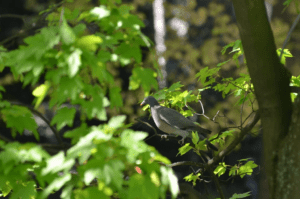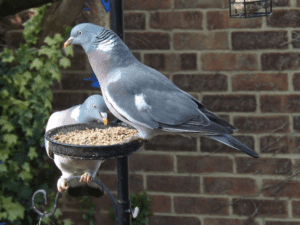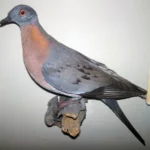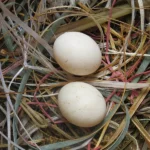Wood pigeons are majestic creatures with a regal appearance and several distinguishing characteristics.
Wood pigeons are the largest and most commonly spotted pigeon variety found in the UK. Here are a few of their key characteristics.
| Characteristic | Wood Pigeon |
| Appearance | Distinct gray-blue body, with pink breasts, iridescent feathers, and red bills. The adults of this species carry white patches on their necks. |
| Size | 300-620 grams (weight)40-45 cms (height) |
| Flying Speed | 50 to 60 miles per hour (average) |
| Population | 51,000,000-73,000,000 (approx) |
| Lifespan | 3 to 17 years |
| Wingspan | 68 to 80 cms |
There is a lot you can learn about wood pigeons. Let us begin by taking you through some interesting facts about them.
What is a wood pigeon?
Wood pigeon is a significantly large species belonging to the pigeon and dove family. These birds are from the native of western Palearctic and are one of the most common pigeon species in the United Kingdom. They are mostly gray with splashes of white, pink, and sometimes, even red or green.

Image Credits: “Wood pigeon” by Noel Reynolds is licensed under CC BY 2.0.
Wood pigeon types
Wood pigeons are of various types. Let us take a look at their subspecies.
| Species | Range |
| European Wood Pigeon | Iraq, Eastern to Western Siberia |
| Asian Wood Pigeon | Northwestern India, Uzbekistan, Northern Afghanistan, Nepal, Pakistan, etc. |
| Azores Wood Pigeon | Central and Eastern Azores |
| North African Wood Pigeon | Algeria, Morocco, Tunisia |
| Iranian Wood Pigeon | Western and Northern Iran, Southern Transcaspia |
How to identify wood pigeons?
Wood pigeons have certain distinguishing characteristics that help us identify them. Allow us to tell you more in this regard.
Wood pigeons can easily be identified by their gray-blue color, with pink breasts and golden eyes. Besides, they have red bills with yellow tips. In addition, look out for the feathers on their neck, which are usually a combination of dazzling green and purple with patches of white on the sides.
How to feed wood pigeons?
To feed wood pigeons, you can lay out a bird table and provide nuts and seeds such as peanuts, sunflower seeds, a mixture of different seeds, and other items like sprouts, cabbages, oats, etc. Besides, wood pigeons are quite fond of cereal grains, often damaging crops in the UK to derive their food.
Wood pigeons can fend for themselves, mostly searching for their food by pecking on the ground. They rely on nuts, fruits, grass seeds, and berries and usually eat three times a day.
How to train wood pigeons?

Image Credits: “Wood pigeons” by Marie Hale is licensed under CC BY 2.0.
Training a wood pigeon is not an easy task, but there are some measures you can take. Here’s a list of them:
- For starters, you need to build a loft for the wood pigeon in accordance with their size and weight. It should preferably have sufficient greenery around it since these pigeons prefer living in well-forested areas.
- The loft should be such that the wood pigeon feels safe enough to rest in it, and there is no chance of predators lurching on them. You can get two or more of them to share the same loft.
- The training program for a pigeon should start when they are six weeks old. Keep the training consistent and start with small tasks such as teaching them to open the loft door or returning to their loft from a fixed distance.
- Remember to take good care of the wood pigeons. Feed them at least twice a day and give them clean water every day. This gives them the incentive to return each time they leave.
- It is important to train your pigeons to come back to their loft. This is known as distance training. You can do this by regularly taking them to a certain location and releasing them. Over time, the pigeon learns to return to their loft.
How to breed wood pigeons?
Breeding wood pigeons requires you to be mindful of a few things. Here they are:
- First, remember that wood pigeons nest between the months of April and October.
- Wood pigeons prefer nesting in deep foliage, hedgerows, large trees, and similar places. So, try to find them a suitable environment. In the absence of trees and foliage, they can also nest in buildings.
- They usually lay two eggs which have an approximate incubation of around 17 days. The incubation process is mostly carried out by the female species, but it is often shared between the two mating birds as well.
- The nestlings are fed on ‘crop milk’ and usually leave their nest within 30-35 days.
Wood pigeons are among the most fertile pigeon species and can breed throughout the year. Usually, in a year, they have 2-3 broods.
Wood pigeon vs. feral pigeon

Image Credits: “Feral pigeon” by Marie Hale is licensed under CC BY 2.0.
There are several points of difference between wood pigeons and feral pigeons. Let’s take a look at them.
| Point of Difference | Wood Pigeon | Feral Pigeon |
| Appearance | Gray-blue body with splashes of pink on the breasts, iridescent greenish-purple feathers, red bill, and prominent white patches on the sides of the neck | Blue-gray head, with splashes of yellow, green, purple and red on its feathers and neck |
| Diet | Root crops, leaves, fruits, flowers, seeds, berries, peanuts, and sprouts | Grains, seeds, fruits, berries with occasional instances of feeding on earthworms, snails, and other insects |
| Habitat | Found mostly in the UK, Western Asia, North Africa, among others. They prefer living in forested areas. | Found on almost all continents except Antarctica. These birds prefer living in semi-open areas. |
| Lifespan | 3-5 years (in the wild)Up to 15 years (in captivity) | 3 years (in the wild)Up to 15-17 years (in captivity) |
| Weight | 300-620 grams | 240-380 grams |
| Length | 40-45 cms | 30-35 cms |
Wood pigeon vs rock pigeon

Image Credits: “rock pigeon” by BigCypressNPS is marked with Public Domain Mark 1.0.
Rock pigeons and wood pigeons have a relatively similar appearance but differ in many ways.
| Point of Difference | Wood Pigeon | Rock Pigeon |
| Appearance | Gray-blue body with splashes of pink on the breasts, iridescent greenish-purple feathers, red bill, and prominent white patches on the sides of the neck | Dark-gray body (can be rusty-red too) with purple-green feathers and a sharp, dark band at the tip of their tail |
| Habitat | Wood pigeons are mostly found in deep forests of the UK, Western Asia, North Africa, etc. | Rock pigeons are found around seaside cliffs or open areas of almost all regions including Europe, North America, and North Africa |
| Weight | 300-620 grams | 240 to 380 grams |
| Length | 40-45 cms | 30-36 cms |
| Diet | Seeds, root crops, fruits, flowers, sprouts, peanuts, etc | Breadcrumbs, seeds, earthworms, snails, berries, etc |
Conclusion
Wood pigeons happen to be one of the most intelligent pigeon species and can easily pass the mirror test. Their population has reduced slightly in recent years, mostly because they fall victim to hunting in several parts of the world. However, their population is still stable, as per IUCN.



